An Examination of Tesco's Leadership and Management Practices
VerifiedAdded on 2020/11/23
|9
|2474
|244
Report
AI Summary
This report examines the leadership and management practices of Tesco, a major UK-based retailer. It begins with a brief history and overview of the company, followed by an analysis of Tesco's vision, leadership styles (including autocratic, democratic, and others), and management practices. The report delves into the implementation of various strategies and their impact on Tesco's success, including the use of democratic leadership and a flat organizational structure. Furthermore, it explores leadership theories such as Contingency Theory and McGregor's Theory X and Y, evaluating their relevance to Tesco's operations. The report concludes with recommendations for improvements in leadership styles and provides references to support its findings. This report highlights Tesco's commitment to quality products, customer satisfaction, and employee motivation and engagement as key factors in its continued market success. The analysis emphasizes how effective leadership and management contribute to the achievement of business objectives and overall organizational growth.
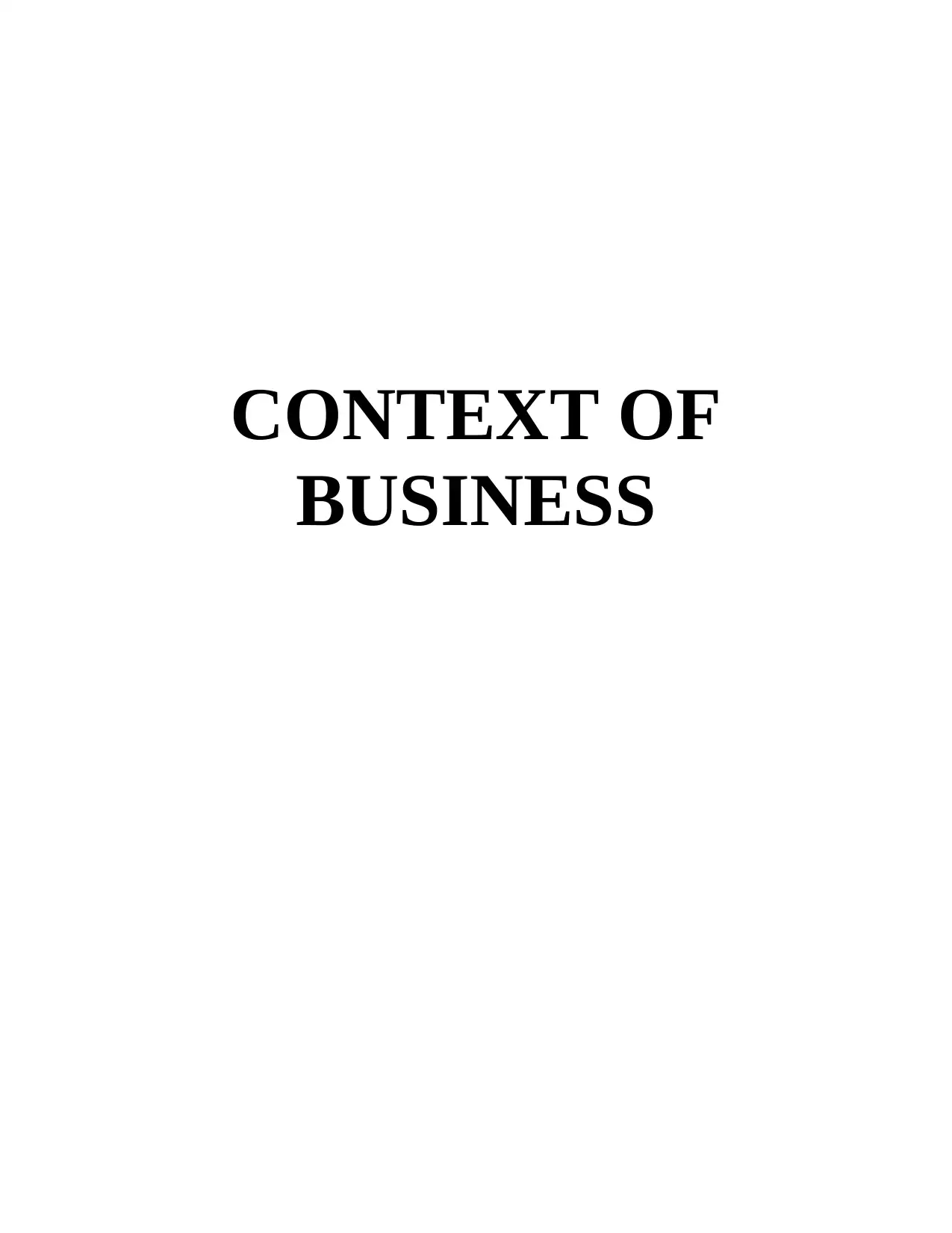
CONTEXT OF
BUSINESS
BUSINESS
Paraphrase This Document
Need a fresh take? Get an instant paraphrase of this document with our AI Paraphraser
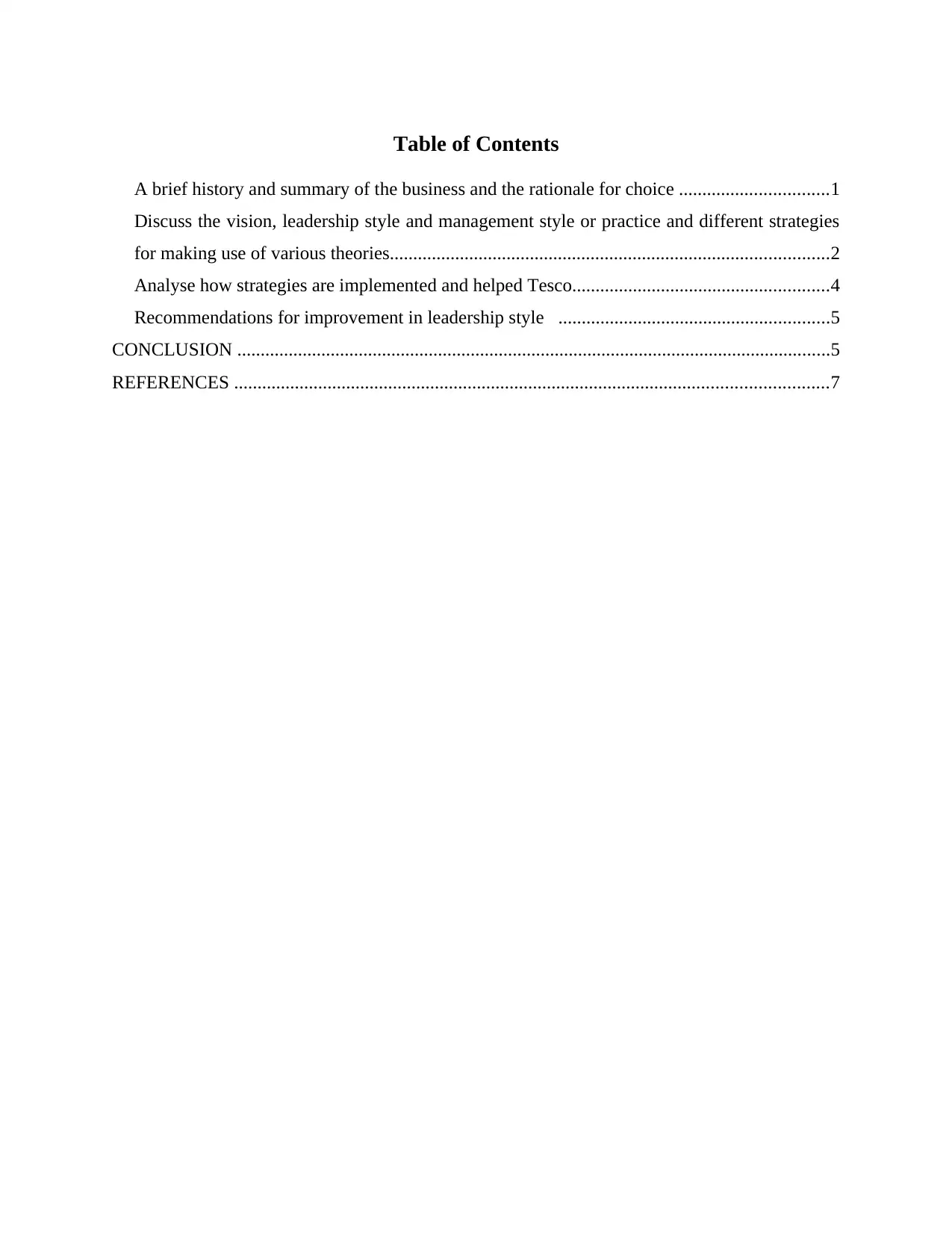
Table of Contents
A brief history and summary of the business and the rationale for choice ................................1
Discuss the vision, leadership style and management style or practice and different strategies
for making use of various theories..............................................................................................2
Analyse how strategies are implemented and helped Tesco.......................................................4
Recommendations for improvement in leadership style ..........................................................5
CONCLUSION ...............................................................................................................................5
REFERENCES ...............................................................................................................................7
A brief history and summary of the business and the rationale for choice ................................1
Discuss the vision, leadership style and management style or practice and different strategies
for making use of various theories..............................................................................................2
Analyse how strategies are implemented and helped Tesco.......................................................4
Recommendations for improvement in leadership style ..........................................................5
CONCLUSION ...............................................................................................................................5
REFERENCES ...............................................................................................................................7

INTRODUCTION
Management and leadership are two important factors which are necessary for
performing tasks of the organization. Leadership is a term used for defining the ability of leaders
and managers to make other work according to their instructions (Dreyer, B and Et. Al., 2017).
Leaders assign goals and objectives to subordinates for meeting the demands and needs of the
organization. These are responsible for giving proper guidance to employees while
accomplishing the task and goals assigned to them. There are various leadership and
management styles used by organizations to achieve the goals and objectives in specified time
frame. They are autocratic, democratic, charismatic, laissez faire, task oriented, charismatic,
bureaucratic, etc. In this report, the company which is considered for analyzing different
leadership and management styles is Tesco. This is a retail firm of UK that was founded in the
year 1919 by Mr. Jack Cohen. This report describes vision of the company, history of the
organization and summary of business. At last of this report, different strategies used by Tesco
for running business successfully are explained.
A brief history and summary of the business and the rationale for choice
History
Tesco was founded in the year 1919 by Jack Cohen. This retail sector industry of UK.
This company was first started by selling of groceries in stalls at East End of London. Tesco was
first appeared as a brand in the year 1924. The first flagship store of Tesco was opened in Burnt
Oak, North London. Tesco continued to have success since it was started. The headquarters of
Tesco was build in north London in the year 1932.
Summary
Tesco operates stores in UK under different banners including Superstone, Extra,
Express and Metro. Tesco ensures customer satisfaction and increase the number of customers.
Tesco is also found on London Stock Exchange (vom Brocke, and et. al., 2016). It has around
£62.54 billion revenue in last year. Tesco is the largest retailer of British and it is also world's
largest retailing outlet. It has more than 4500 locations in UK. It has a workforce of around
552004 employees. This company focuses on motivating and supporting it's employees to work
hard and achieve specified targets. It has a well trained workforce and a huge customer base.
1
Management and leadership are two important factors which are necessary for
performing tasks of the organization. Leadership is a term used for defining the ability of leaders
and managers to make other work according to their instructions (Dreyer, B and Et. Al., 2017).
Leaders assign goals and objectives to subordinates for meeting the demands and needs of the
organization. These are responsible for giving proper guidance to employees while
accomplishing the task and goals assigned to them. There are various leadership and
management styles used by organizations to achieve the goals and objectives in specified time
frame. They are autocratic, democratic, charismatic, laissez faire, task oriented, charismatic,
bureaucratic, etc. In this report, the company which is considered for analyzing different
leadership and management styles is Tesco. This is a retail firm of UK that was founded in the
year 1919 by Mr. Jack Cohen. This report describes vision of the company, history of the
organization and summary of business. At last of this report, different strategies used by Tesco
for running business successfully are explained.
A brief history and summary of the business and the rationale for choice
History
Tesco was founded in the year 1919 by Jack Cohen. This retail sector industry of UK.
This company was first started by selling of groceries in stalls at East End of London. Tesco was
first appeared as a brand in the year 1924. The first flagship store of Tesco was opened in Burnt
Oak, North London. Tesco continued to have success since it was started. The headquarters of
Tesco was build in north London in the year 1932.
Summary
Tesco operates stores in UK under different banners including Superstone, Extra,
Express and Metro. Tesco ensures customer satisfaction and increase the number of customers.
Tesco is also found on London Stock Exchange (vom Brocke, and et. al., 2016). It has around
£62.54 billion revenue in last year. Tesco is the largest retailer of British and it is also world's
largest retailing outlet. It has more than 4500 locations in UK. It has a workforce of around
552004 employees. This company focuses on motivating and supporting it's employees to work
hard and achieve specified targets. It has a well trained workforce and a huge customer base.
1
⊘ This is a preview!⊘
Do you want full access?
Subscribe today to unlock all pages.

Trusted by 1+ million students worldwide
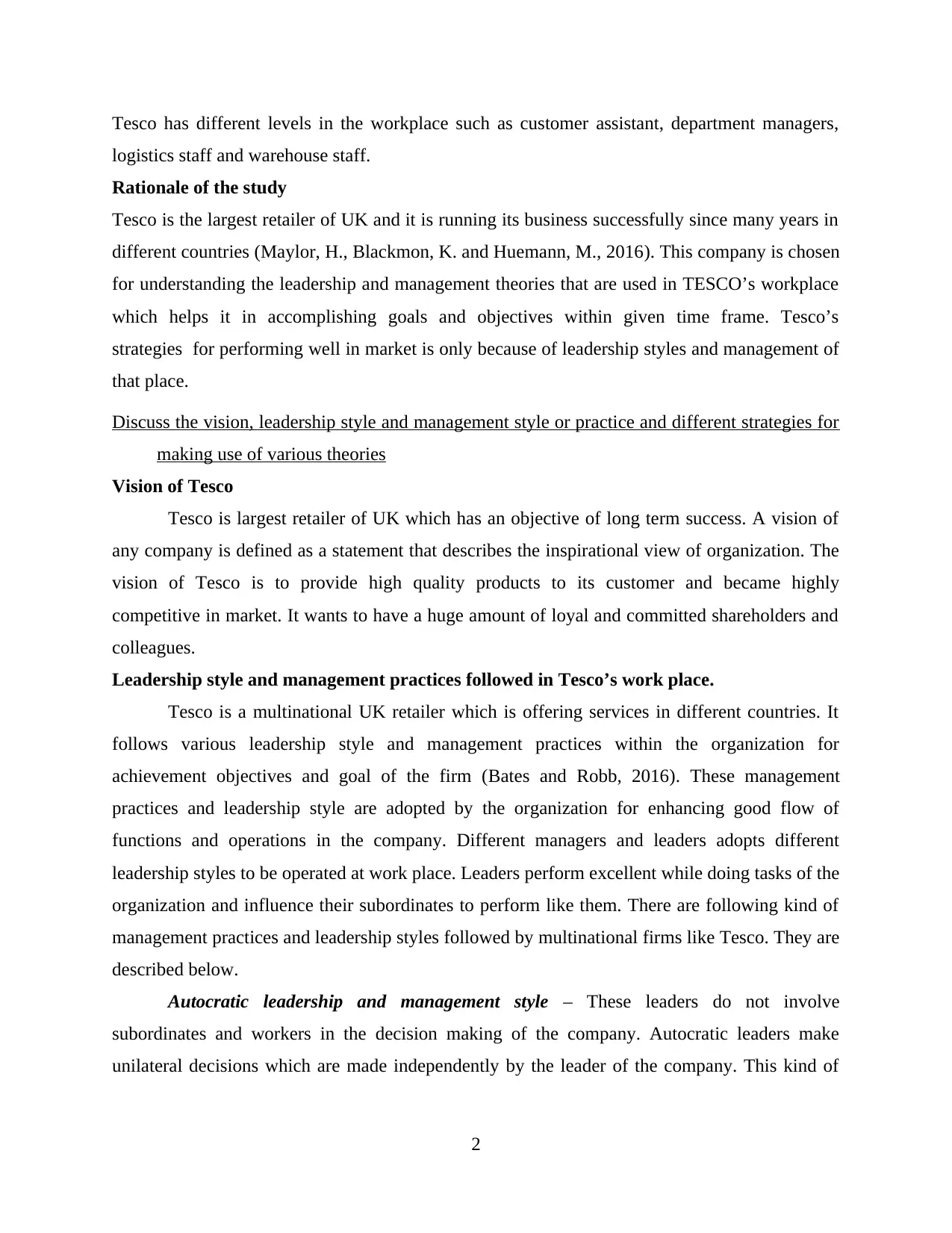
Tesco has different levels in the workplace such as customer assistant, department managers,
logistics staff and warehouse staff.
Rationale of the study
Tesco is the largest retailer of UK and it is running its business successfully since many years in
different countries (Maylor, H., Blackmon, K. and Huemann, M., 2016). This company is chosen
for understanding the leadership and management theories that are used in TESCO’s workplace
which helps it in accomplishing goals and objectives within given time frame. Tesco’s
strategies for performing well in market is only because of leadership styles and management of
that place.
Discuss the vision, leadership style and management style or practice and different strategies for
making use of various theories
Vision of Tesco
Tesco is largest retailer of UK which has an objective of long term success. A vision of
any company is defined as a statement that describes the inspirational view of organization. The
vision of Tesco is to provide high quality products to its customer and became highly
competitive in market. It wants to have a huge amount of loyal and committed shareholders and
colleagues.
Leadership style and management practices followed in Tesco’s work place.
Tesco is a multinational UK retailer which is offering services in different countries. It
follows various leadership style and management practices within the organization for
achievement objectives and goal of the firm (Bates and Robb, 2016). These management
practices and leadership style are adopted by the organization for enhancing good flow of
functions and operations in the company. Different managers and leaders adopts different
leadership styles to be operated at work place. Leaders perform excellent while doing tasks of the
organization and influence their subordinates to perform like them. There are following kind of
management practices and leadership styles followed by multinational firms like Tesco. They are
described below.
Autocratic leadership and management style – These leaders do not involve
subordinates and workers in the decision making of the company. Autocratic leaders make
unilateral decisions which are made independently by the leader of the company. This kind of
2
logistics staff and warehouse staff.
Rationale of the study
Tesco is the largest retailer of UK and it is running its business successfully since many years in
different countries (Maylor, H., Blackmon, K. and Huemann, M., 2016). This company is chosen
for understanding the leadership and management theories that are used in TESCO’s workplace
which helps it in accomplishing goals and objectives within given time frame. Tesco’s
strategies for performing well in market is only because of leadership styles and management of
that place.
Discuss the vision, leadership style and management style or practice and different strategies for
making use of various theories
Vision of Tesco
Tesco is largest retailer of UK which has an objective of long term success. A vision of
any company is defined as a statement that describes the inspirational view of organization. The
vision of Tesco is to provide high quality products to its customer and became highly
competitive in market. It wants to have a huge amount of loyal and committed shareholders and
colleagues.
Leadership style and management practices followed in Tesco’s work place.
Tesco is a multinational UK retailer which is offering services in different countries. It
follows various leadership style and management practices within the organization for
achievement objectives and goal of the firm (Bates and Robb, 2016). These management
practices and leadership style are adopted by the organization for enhancing good flow of
functions and operations in the company. Different managers and leaders adopts different
leadership styles to be operated at work place. Leaders perform excellent while doing tasks of the
organization and influence their subordinates to perform like them. There are following kind of
management practices and leadership styles followed by multinational firms like Tesco. They are
described below.
Autocratic leadership and management style – These leaders do not involve
subordinates and workers in the decision making of the company. Autocratic leaders make
unilateral decisions which are made independently by the leader of the company. This kind of
2
Paraphrase This Document
Need a fresh take? Get an instant paraphrase of this document with our AI Paraphraser
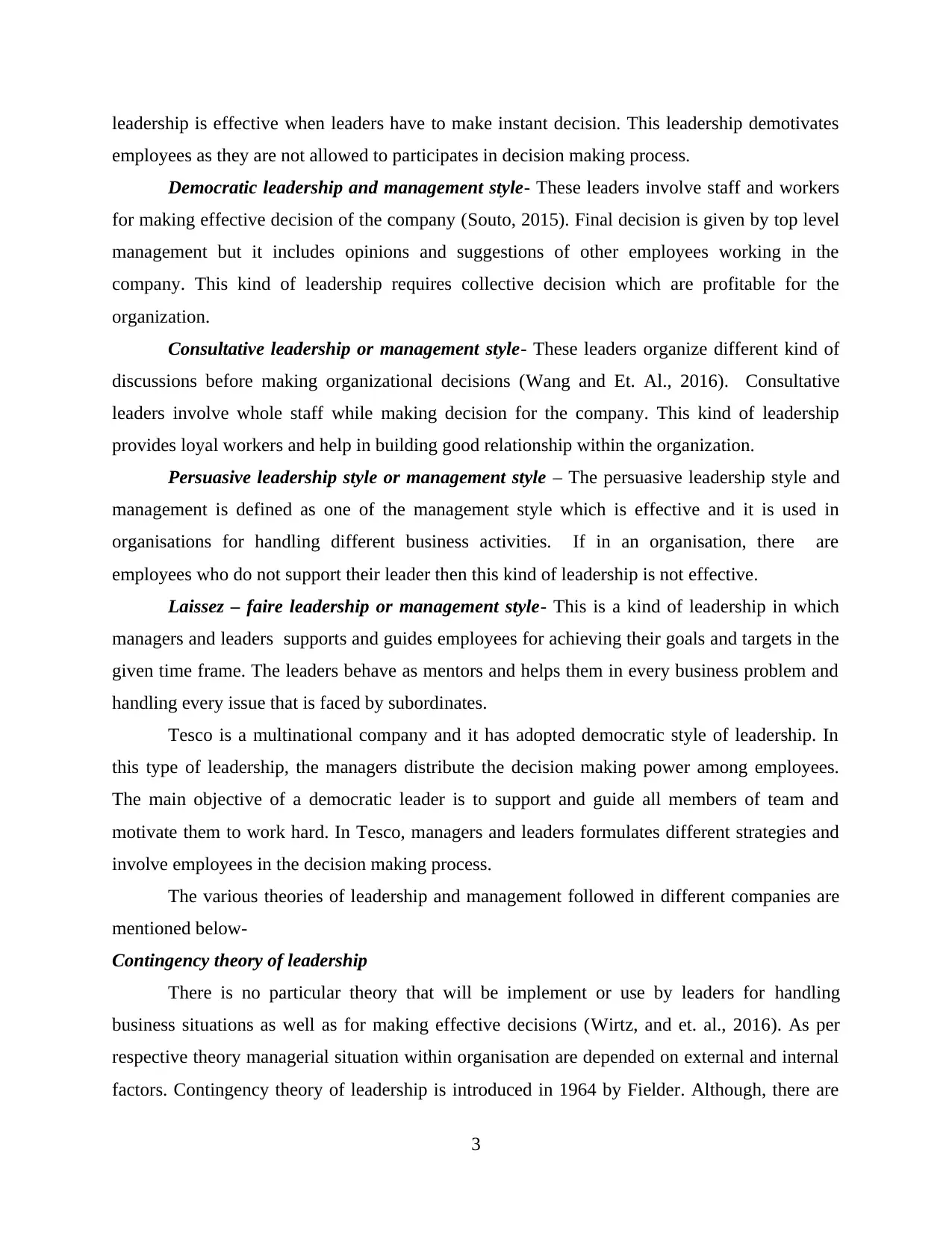
leadership is effective when leaders have to make instant decision. This leadership demotivates
employees as they are not allowed to participates in decision making process.
Democratic leadership and management style- These leaders involve staff and workers
for making effective decision of the company (Souto, 2015). Final decision is given by top level
management but it includes opinions and suggestions of other employees working in the
company. This kind of leadership requires collective decision which are profitable for the
organization.
Consultative leadership or management style- These leaders organize different kind of
discussions before making organizational decisions (Wang and Et. Al., 2016). Consultative
leaders involve whole staff while making decision for the company. This kind of leadership
provides loyal workers and help in building good relationship within the organization.
Persuasive leadership style or management style – The persuasive leadership style and
management is defined as one of the management style which is effective and it is used in
organisations for handling different business activities. If in an organisation, there are
employees who do not support their leader then this kind of leadership is not effective.
Laissez – faire leadership or management style- This is a kind of leadership in which
managers and leaders supports and guides employees for achieving their goals and targets in the
given time frame. The leaders behave as mentors and helps them in every business problem and
handling every issue that is faced by subordinates.
Tesco is a multinational company and it has adopted democratic style of leadership. In
this type of leadership, the managers distribute the decision making power among employees.
The main objective of a democratic leader is to support and guide all members of team and
motivate them to work hard. In Tesco, managers and leaders formulates different strategies and
involve employees in the decision making process.
The various theories of leadership and management followed in different companies are
mentioned below-
Contingency theory of leadership
There is no particular theory that will be implement or use by leaders for handling
business situations as well as for making effective decisions (Wirtz, and et. al., 2016). As per
respective theory managerial situation within organisation are depended on external and internal
factors. Contingency theory of leadership is introduced in 1964 by Fielder. Although, there are
3
employees as they are not allowed to participates in decision making process.
Democratic leadership and management style- These leaders involve staff and workers
for making effective decision of the company (Souto, 2015). Final decision is given by top level
management but it includes opinions and suggestions of other employees working in the
company. This kind of leadership requires collective decision which are profitable for the
organization.
Consultative leadership or management style- These leaders organize different kind of
discussions before making organizational decisions (Wang and Et. Al., 2016). Consultative
leaders involve whole staff while making decision for the company. This kind of leadership
provides loyal workers and help in building good relationship within the organization.
Persuasive leadership style or management style – The persuasive leadership style and
management is defined as one of the management style which is effective and it is used in
organisations for handling different business activities. If in an organisation, there are
employees who do not support their leader then this kind of leadership is not effective.
Laissez – faire leadership or management style- This is a kind of leadership in which
managers and leaders supports and guides employees for achieving their goals and targets in the
given time frame. The leaders behave as mentors and helps them in every business problem and
handling every issue that is faced by subordinates.
Tesco is a multinational company and it has adopted democratic style of leadership. In
this type of leadership, the managers distribute the decision making power among employees.
The main objective of a democratic leader is to support and guide all members of team and
motivate them to work hard. In Tesco, managers and leaders formulates different strategies and
involve employees in the decision making process.
The various theories of leadership and management followed in different companies are
mentioned below-
Contingency theory of leadership
There is no particular theory that will be implement or use by leaders for handling
business situations as well as for making effective decisions (Wirtz, and et. al., 2016). As per
respective theory managerial situation within organisation are depended on external and internal
factors. Contingency theory of leadership is introduced in 1964 by Fielder. Although, there are
3
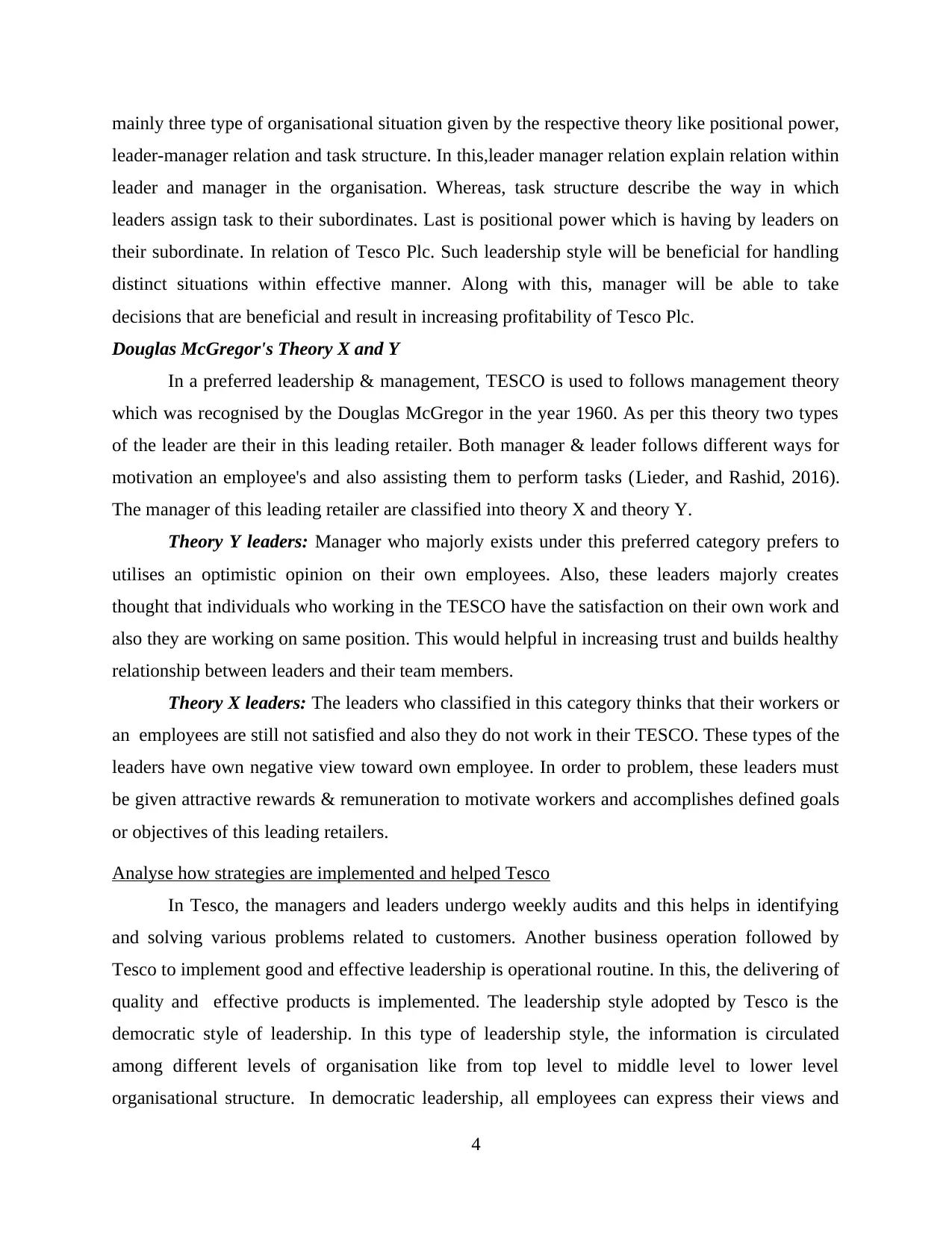
mainly three type of organisational situation given by the respective theory like positional power,
leader-manager relation and task structure. In this,leader manager relation explain relation within
leader and manager in the organisation. Whereas, task structure describe the way in which
leaders assign task to their subordinates. Last is positional power which is having by leaders on
their subordinate. In relation of Tesco Plc. Such leadership style will be beneficial for handling
distinct situations within effective manner. Along with this, manager will be able to take
decisions that are beneficial and result in increasing profitability of Tesco Plc.
Douglas McGregor's Theory X and Y
In a preferred leadership & management, TESCO is used to follows management theory
which was recognised by the Douglas McGregor in the year 1960. As per this theory two types
of the leader are their in this leading retailer. Both manager & leader follows different ways for
motivation an employee's and also assisting them to perform tasks (Lieder, and Rashid, 2016).
The manager of this leading retailer are classified into theory X and theory Y.
Theory Y leaders: Manager who majorly exists under this preferred category prefers to
utilises an optimistic opinion on their own employees. Also, these leaders majorly creates
thought that individuals who working in the TESCO have the satisfaction on their own work and
also they are working on same position. This would helpful in increasing trust and builds healthy
relationship between leaders and their team members.
Theory X leaders: The leaders who classified in this category thinks that their workers or
an employees are still not satisfied and also they do not work in their TESCO. These types of the
leaders have own negative view toward own employee. In order to problem, these leaders must
be given attractive rewards & remuneration to motivate workers and accomplishes defined goals
or objectives of this leading retailers.
Analyse how strategies are implemented and helped Tesco
In Tesco, the managers and leaders undergo weekly audits and this helps in identifying
and solving various problems related to customers. Another business operation followed by
Tesco to implement good and effective leadership is operational routine. In this, the delivering of
quality and effective products is implemented. The leadership style adopted by Tesco is the
democratic style of leadership. In this type of leadership style, the information is circulated
among different levels of organisation like from top level to middle level to lower level
organisational structure. In democratic leadership, all employees can express their views and
4
leader-manager relation and task structure. In this,leader manager relation explain relation within
leader and manager in the organisation. Whereas, task structure describe the way in which
leaders assign task to their subordinates. Last is positional power which is having by leaders on
their subordinate. In relation of Tesco Plc. Such leadership style will be beneficial for handling
distinct situations within effective manner. Along with this, manager will be able to take
decisions that are beneficial and result in increasing profitability of Tesco Plc.
Douglas McGregor's Theory X and Y
In a preferred leadership & management, TESCO is used to follows management theory
which was recognised by the Douglas McGregor in the year 1960. As per this theory two types
of the leader are their in this leading retailer. Both manager & leader follows different ways for
motivation an employee's and also assisting them to perform tasks (Lieder, and Rashid, 2016).
The manager of this leading retailer are classified into theory X and theory Y.
Theory Y leaders: Manager who majorly exists under this preferred category prefers to
utilises an optimistic opinion on their own employees. Also, these leaders majorly creates
thought that individuals who working in the TESCO have the satisfaction on their own work and
also they are working on same position. This would helpful in increasing trust and builds healthy
relationship between leaders and their team members.
Theory X leaders: The leaders who classified in this category thinks that their workers or
an employees are still not satisfied and also they do not work in their TESCO. These types of the
leaders have own negative view toward own employee. In order to problem, these leaders must
be given attractive rewards & remuneration to motivate workers and accomplishes defined goals
or objectives of this leading retailers.
Analyse how strategies are implemented and helped Tesco
In Tesco, the managers and leaders undergo weekly audits and this helps in identifying
and solving various problems related to customers. Another business operation followed by
Tesco to implement good and effective leadership is operational routine. In this, the delivering of
quality and effective products is implemented. The leadership style adopted by Tesco is the
democratic style of leadership. In this type of leadership style, the information is circulated
among different levels of organisation like from top level to middle level to lower level
organisational structure. In democratic leadership, all employees can express their views and
4
⊘ This is a preview!⊘
Do you want full access?
Subscribe today to unlock all pages.

Trusted by 1+ million students worldwide
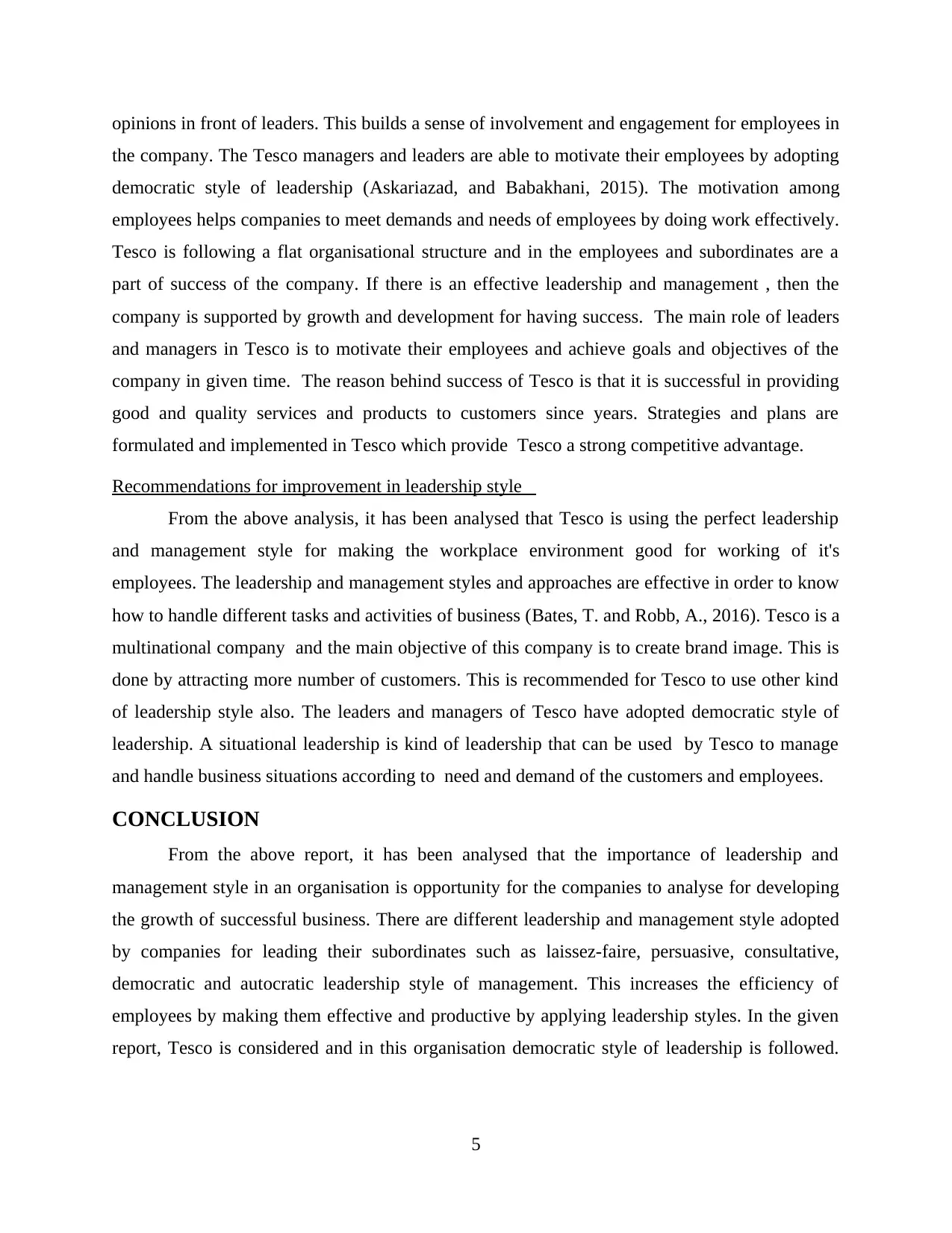
opinions in front of leaders. This builds a sense of involvement and engagement for employees in
the company. The Tesco managers and leaders are able to motivate their employees by adopting
democratic style of leadership (Askariazad, and Babakhani, 2015). The motivation among
employees helps companies to meet demands and needs of employees by doing work effectively.
Tesco is following a flat organisational structure and in the employees and subordinates are a
part of success of the company. If there is an effective leadership and management , then the
company is supported by growth and development for having success. The main role of leaders
and managers in Tesco is to motivate their employees and achieve goals and objectives of the
company in given time. The reason behind success of Tesco is that it is successful in providing
good and quality services and products to customers since years. Strategies and plans are
formulated and implemented in Tesco which provide Tesco a strong competitive advantage.
Recommendations for improvement in leadership style
From the above analysis, it has been analysed that Tesco is using the perfect leadership
and management style for making the workplace environment good for working of it's
employees. The leadership and management styles and approaches are effective in order to know
how to handle different tasks and activities of business (Bates, T. and Robb, A., 2016). Tesco is a
multinational company and the main objective of this company is to create brand image. This is
done by attracting more number of customers. This is recommended for Tesco to use other kind
of leadership style also. The leaders and managers of Tesco have adopted democratic style of
leadership. A situational leadership is kind of leadership that can be used by Tesco to manage
and handle business situations according to need and demand of the customers and employees.
CONCLUSION
From the above report, it has been analysed that the importance of leadership and
management style in an organisation is opportunity for the companies to analyse for developing
the growth of successful business. There are different leadership and management style adopted
by companies for leading their subordinates such as laissez-faire, persuasive, consultative,
democratic and autocratic leadership style of management. This increases the efficiency of
employees by making them effective and productive by applying leadership styles. In the given
report, Tesco is considered and in this organisation democratic style of leadership is followed.
5
the company. The Tesco managers and leaders are able to motivate their employees by adopting
democratic style of leadership (Askariazad, and Babakhani, 2015). The motivation among
employees helps companies to meet demands and needs of employees by doing work effectively.
Tesco is following a flat organisational structure and in the employees and subordinates are a
part of success of the company. If there is an effective leadership and management , then the
company is supported by growth and development for having success. The main role of leaders
and managers in Tesco is to motivate their employees and achieve goals and objectives of the
company in given time. The reason behind success of Tesco is that it is successful in providing
good and quality services and products to customers since years. Strategies and plans are
formulated and implemented in Tesco which provide Tesco a strong competitive advantage.
Recommendations for improvement in leadership style
From the above analysis, it has been analysed that Tesco is using the perfect leadership
and management style for making the workplace environment good for working of it's
employees. The leadership and management styles and approaches are effective in order to know
how to handle different tasks and activities of business (Bates, T. and Robb, A., 2016). Tesco is a
multinational company and the main objective of this company is to create brand image. This is
done by attracting more number of customers. This is recommended for Tesco to use other kind
of leadership style also. The leaders and managers of Tesco have adopted democratic style of
leadership. A situational leadership is kind of leadership that can be used by Tesco to manage
and handle business situations according to need and demand of the customers and employees.
CONCLUSION
From the above report, it has been analysed that the importance of leadership and
management style in an organisation is opportunity for the companies to analyse for developing
the growth of successful business. There are different leadership and management style adopted
by companies for leading their subordinates such as laissez-faire, persuasive, consultative,
democratic and autocratic leadership style of management. This increases the efficiency of
employees by making them effective and productive by applying leadership styles. In the given
report, Tesco is considered and in this organisation democratic style of leadership is followed.
5
Paraphrase This Document
Need a fresh take? Get an instant paraphrase of this document with our AI Paraphraser
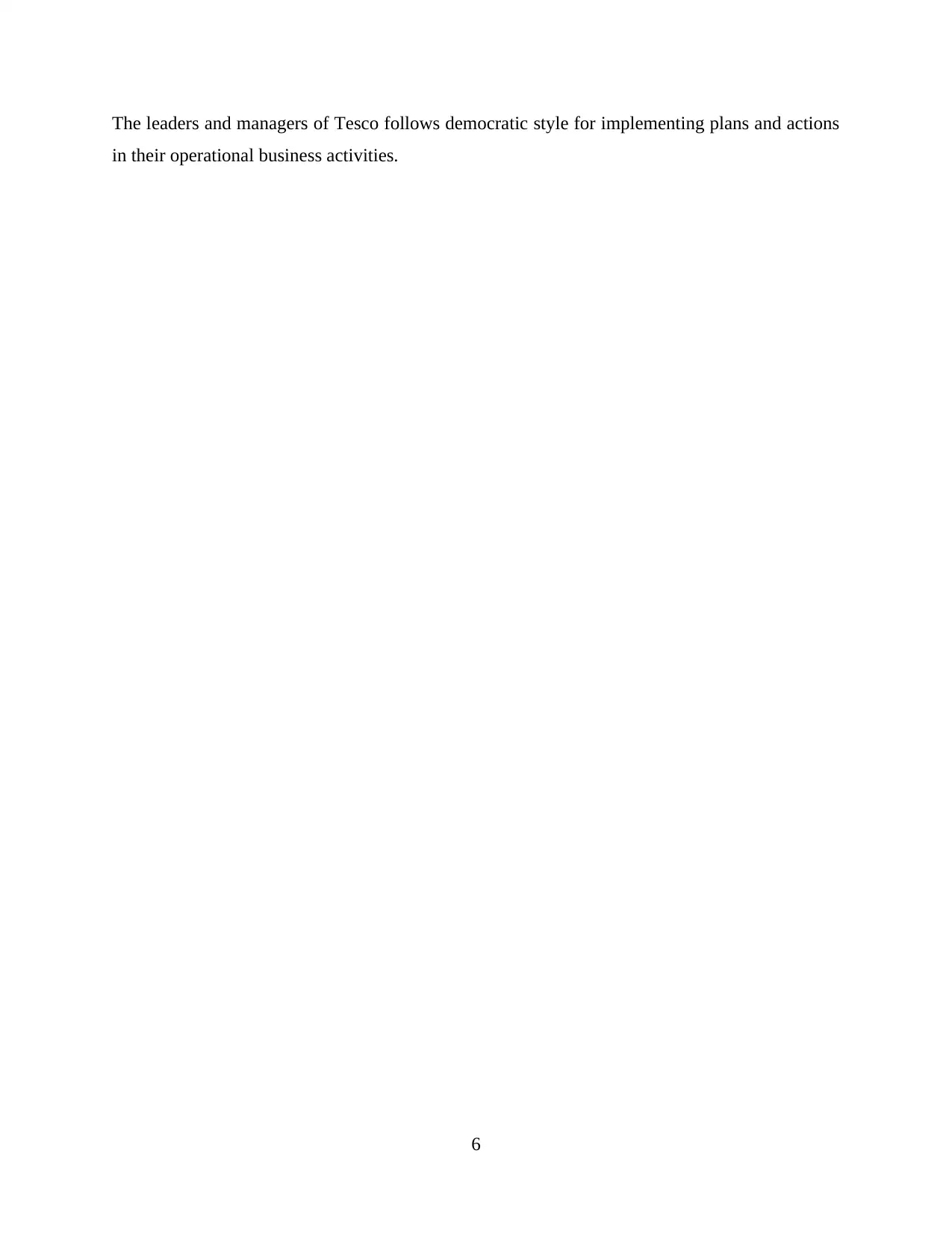
The leaders and managers of Tesco follows democratic style for implementing plans and actions
in their operational business activities.
6
in their operational business activities.
6
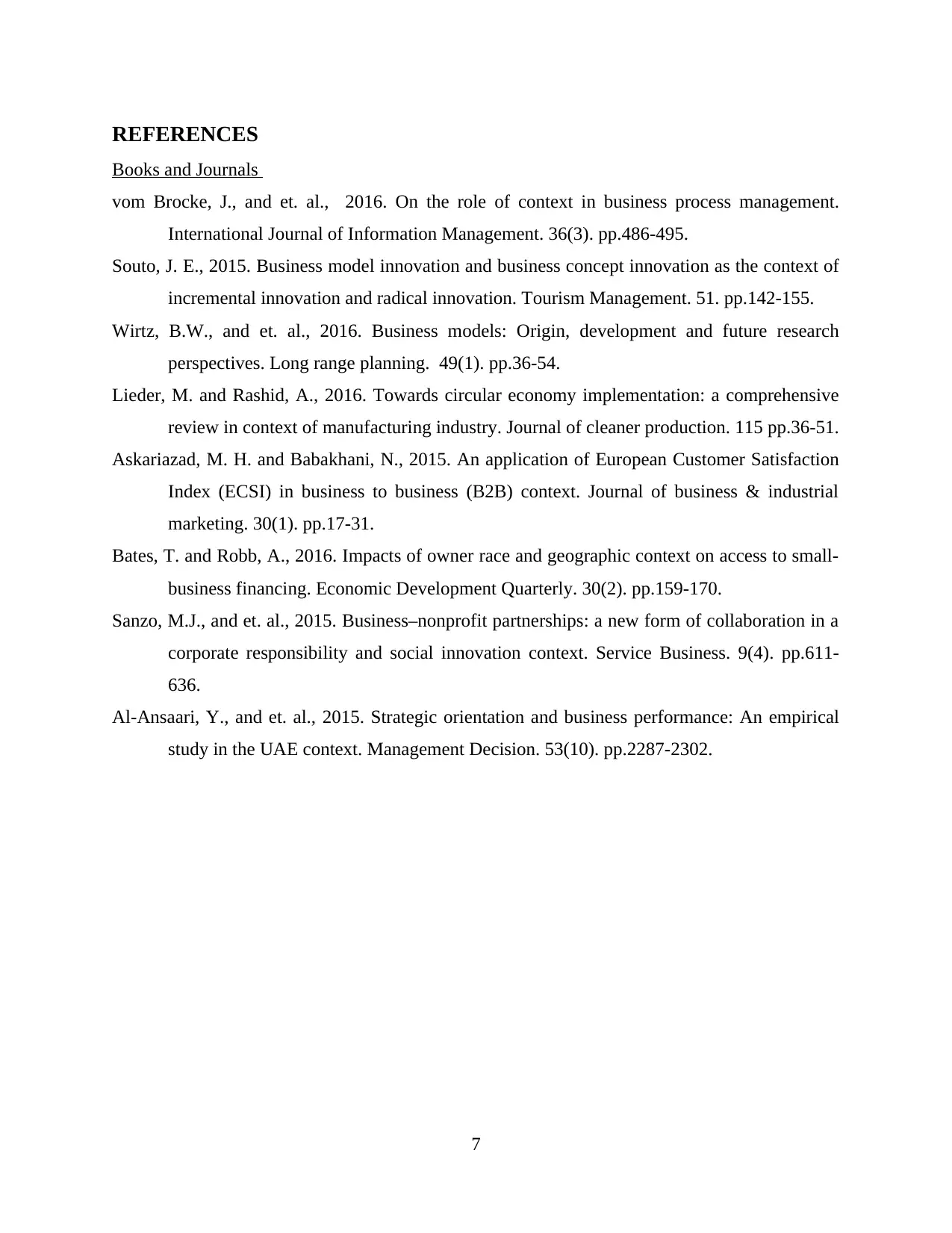
REFERENCES
Books and Journals
vom Brocke, J., and et. al., 2016. On the role of context in business process management.
International Journal of Information Management. 36(3). pp.486-495.
Souto, J. E., 2015. Business model innovation and business concept innovation as the context of
incremental innovation and radical innovation. Tourism Management. 51. pp.142-155.
Wirtz, B.W., and et. al., 2016. Business models: Origin, development and future research
perspectives. Long range planning. 49(1). pp.36-54.
Lieder, M. and Rashid, A., 2016. Towards circular economy implementation: a comprehensive
review in context of manufacturing industry. Journal of cleaner production. 115 pp.36-51.
Askariazad, M. H. and Babakhani, N., 2015. An application of European Customer Satisfaction
Index (ECSI) in business to business (B2B) context. Journal of business & industrial
marketing. 30(1). pp.17-31.
Bates, T. and Robb, A., 2016. Impacts of owner race and geographic context on access to small-
business financing. Economic Development Quarterly. 30(2). pp.159-170.
Sanzo, M.J., and et. al., 2015. Business–nonprofit partnerships: a new form of collaboration in a
corporate responsibility and social innovation context. Service Business. 9(4). pp.611-
636.
Al-Ansaari, Y., and et. al., 2015. Strategic orientation and business performance: An empirical
study in the UAE context. Management Decision. 53(10). pp.2287-2302.
7
Books and Journals
vom Brocke, J., and et. al., 2016. On the role of context in business process management.
International Journal of Information Management. 36(3). pp.486-495.
Souto, J. E., 2015. Business model innovation and business concept innovation as the context of
incremental innovation and radical innovation. Tourism Management. 51. pp.142-155.
Wirtz, B.W., and et. al., 2016. Business models: Origin, development and future research
perspectives. Long range planning. 49(1). pp.36-54.
Lieder, M. and Rashid, A., 2016. Towards circular economy implementation: a comprehensive
review in context of manufacturing industry. Journal of cleaner production. 115 pp.36-51.
Askariazad, M. H. and Babakhani, N., 2015. An application of European Customer Satisfaction
Index (ECSI) in business to business (B2B) context. Journal of business & industrial
marketing. 30(1). pp.17-31.
Bates, T. and Robb, A., 2016. Impacts of owner race and geographic context on access to small-
business financing. Economic Development Quarterly. 30(2). pp.159-170.
Sanzo, M.J., and et. al., 2015. Business–nonprofit partnerships: a new form of collaboration in a
corporate responsibility and social innovation context. Service Business. 9(4). pp.611-
636.
Al-Ansaari, Y., and et. al., 2015. Strategic orientation and business performance: An empirical
study in the UAE context. Management Decision. 53(10). pp.2287-2302.
7
⊘ This is a preview!⊘
Do you want full access?
Subscribe today to unlock all pages.

Trusted by 1+ million students worldwide
1 out of 9
Related Documents
Your All-in-One AI-Powered Toolkit for Academic Success.
+13062052269
info@desklib.com
Available 24*7 on WhatsApp / Email
![[object Object]](/_next/static/media/star-bottom.7253800d.svg)
Unlock your academic potential
Copyright © 2020–2025 A2Z Services. All Rights Reserved. Developed and managed by ZUCOL.




